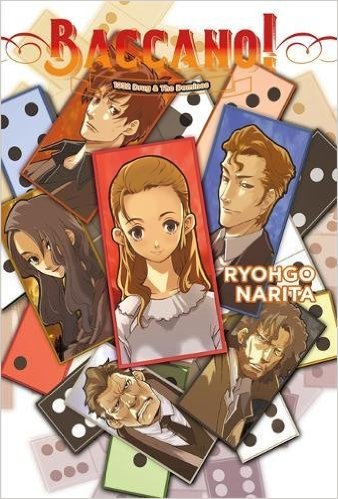By Ryohgo Narita and Katsumi Enami. Released in Japan by ASCII Mediaworks. Released in North America by Yen On. Translated by Taylor Engel.
This was the final Baccano! light novel that was used in the 2007 anime adaptation, but even if you’ve seen the anime you should read this anyway, as it’s startling how much was left out and how much was changed. The anime needed a little bit more plot to add to its “let’s move back and forth between various time periods” style, and Eve’s subplot seemed to fit the bill. They had little to no use for Roy Maddock and his drug addiction, though, and so he was completely eliminated. Which is a shame, as while I have little use for Roy himself, who is not as interesting as virtually everyone else in this book, his girlfriend Edith is awesome, and having Roy also means we meet Kate Gandor, Keith’s wife – and actually hear Keith speak more than a few lines of dialogue!
Eve Genoard, younger sister to ne’er-do-well Dallas, is front and center on the cover, and I’d wager that she gets to have the hero’s journey here – as I said before, Roy is a bit too flat for me to really grant that to him. You could argue that Luck Gandor may also qualify – he’s worrying that he’s lost an essential humanity since becoming immortal, and it’s through dealing with Eve and the Runoratas that he comes to accept who he is now and realize that he hasn’t changed as much as he thought. He’s certainly unrepentant about what he did to Dallas – who, let’s remember, killed several men in the Gandor mafia clan – but he allows Eve a chance to possibly rescue Dallas from his watery grave. (Luck wonders why he was so soft-hearted, which is hilarious given that earlier in the book, all three Gandors were terrified about the idea of having to punish a woman, mafia-style, for betrayal – they end up giving her a haircut.)
This happens right after the last two books – in fact, the first third of it actually happens before the last two books, as it begins in late December 1931 and ends in early January 1932. And we do see characters from the previous books. Isaac and Miria have a smaller role than usual, but it’s their theft of the Gandor Family Fortune which sets most of this in motion, and their obsession with dominoes that gives us some more comedy, though I think it’s REALLY OBVIOUS that Narita only added that plot so he could use the title, which comes from Eric Clapton’s band Derek and the Dominoes. Firo spends most of the book grumbling and whining, which seems a bit out of character for him. And we also see a few people who look like they’re being introduced for future books, such as Tick, the Gandor family’s smiling torture specialist, and Maria, a walking Mexican stereotype who can’t stop saying “amigo” but who is a lot of fun anyway. The Daily Days also get a lot more here to do than usual, and the one morally dubious guy of their bunch gets his after a ride on the Rail Tracer express (not lethal, for once).
That said, the book ends with a sort of tragedy, and it involves another immortal who appears throughout the book – Begg, who seems to have been one of Maiza’s group who became immortal back in 1711. He’s now the Runorata family drug expert, and spends his years trying to perfect a drug that will make everyone live in their own happy world, with no problems or worries. Given the halting, jittery way he speaks, you get the feeling he’s tested a lot of drugs on himself. And, despite an attempt at a heartwarming scene with Czeslaw (which is also rife with foreshadowing), in the end we see him at the start of the 21st century, burned out in an institution, barely able to respond to Maiza. Immortals may live forever, but they can still damage their mind, and it’s sad to see, even if you question the entire premise of what Begg wanted to achieve.
All in all, a good addition to the series, with lots of fun stuff happening, though I don’t think it hits the heights of Book 2. Next time we’ll move forward a bit – quite a bit – and see what the cast is up to in 2001.


This is Rev (agallimaufryofoddments) from Tumblr – saw Yen Press retweet your review via the wiki account.
Just want to correct the (mistype?) re the anime adaptation year – the Brain’s Base adaptation aired in 2007, not 2006.
Also, I assume that by “anime adaptation” you were only referring to the first thirteen episodes that aired when you said that LN#4 was the final novel adapted to the anime, since Graham Specter’s kidnapping plot from the OVAs is derived from the fourteenth light novel 1931 Another Junk Railroad: Special Express Episode (the OVAs also cherry pick dialogue and monologues from other novels, if I remember right).
I fixed the post to say 2007 – thanks.
I’ll be honest, I don’t think the producers kept Another Junk Railroad in mind at all when filming the first 13 – the main series and OAVs seem a bit disconnected from each other. I meant 4 was the last for the main TV series.